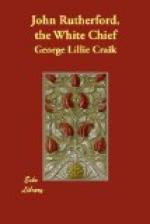Rutherford, as his narrative shows, was ten years amongst the Maoris. He was an ignorant sailor. He could not write, and the account of his adventures, it is explained, was dictated to a friend while he was on the voyage back to England. Craik says that if allowance is made for some grammatical solecisms, the story, as it appeared in the manuscript, was told with great clearness, and sometimes with considerable spirit. Knight evidently knew him, as it is stated in “The New Zealanders” that “the publisher of this volume had many conversations with him when he was exhibited in London.” It is probable, too, that Brougham knew him. Brougham, indeed, may have “discovered” him and introduced him to Knight. Rutherford was just the kind of man in whose company Brougham delighted to spend hours. He would listen to the recital of the thrilling adventures with the Maoris with breathless interest. A story told of the madcap days of Brougham’s youth gives some idea of the welcome he would extend to Rutherford. One evening, after Brougham and some other gay spirits had supped together in London, they saw a mob of idle scoundrels beating an unfortunate woman with brutal ferocity. The young fellows went to her rescue. Their interference increased the tumult, and all the watchmen in the neighbourhood were soon about their ears. In return for their chivalry they were lodged in the watch-house. Amongst their fellow-prisoners there was an old sailor, who sat cowering over the embers of the fire. He had been in the American War. Brougham picked up an acquaintance with him, and all night long the young man held the old one in conversation, ascertaining the strength of the forces in the engagements, the scenes of the battles, the nature of the manoeuvres, the advances and reverses, and so on, until his avariciousness for knowledge was satisfied.
Neither Brougham nor Knight, nor even Craik, had sufficient means of testing the accuracy of Rutherford’s story. Unfortunately there are many points on which the narrative is not only inaccurate but misleading. Craik concludes that Poverty Bay, where Cook first landed in New Zealand, is the scene of the capture of the “Agnes.” Rutherford, however, gives the name as “Tokomardo.” This corresponds with a bay some miles further north, and about forty miles from the East Cape. The Maoris call it Tokomaru, which Rutherford evidently intended. His description of the place might represent Tokomaru almost as well as Poverty Bay. The strangest part of the affair, however, is that the Maoris on that coast have no knowledge whatever of the “Agnes,” the vessel which, according to Rutherford, was captured in the bay he describes. Eighty years ago the arrival of a vessel at New Zealand was an advent of the utmost importance. The news spread throughout the land with surprising rapidity, and whole tribes flocked to the port to see the “Pakehas” and trade for their iron implements and guns. The Maoris of the district know of three white men,




